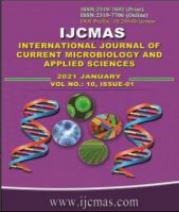


 National Academy of Agricultural Sciences (NAAS)
National Academy of Agricultural Sciences (NAAS)

|
PRINT ISSN : 2319-7692
Online ISSN : 2319-7706 Issues : 12 per year Publisher : Excellent Publishers Email : editorijcmas@gmail.com / submit@ijcmas.com Editor-in-chief: Dr.M.Prakash Index Copernicus ICV 2018: 95.39 NAAS RATING 2020: 5.38 |
The present study was conducted during 2017-2018 at College of Horticulture, Mudigere with an objective to know the effect of bunch feeding and bunch spraying on fruit nutrient status and cost economics of tissue culture banana cv. Ney poovan under hill zone of Karnataka. The distal stalk of banana bunch was fed with different nutrient sources like urea, sulphate of potash, banana special and organic formulations like panchagavya and amritpani. The bunch spraying was done thrice with growth regulator 2,4-D at 30 ppm at monthly interval starting from shoot initiation and compared with control (without bunch feeding and bunch spraying). The results revealed that the highest nitrogen (0.84 %), phosphorous (0.14 %) and potassium (0.92 %) content in the fruit was found in T5 (Bunch spray with 2, 4-D 30 ppm + T2 -Bunch feeding with Urea 7.5 g + SOP 7.5 g) as against control (0.60 %, 0.07 % and 0.70 %, respectively). Whereas, highest calcium (0.22 %), magnesium (0.138 %), sulphur (0.47 %), zinc (19.87 ppm), boron (20.32 ppm), iron (124.51 ppm) and manganese (102.46 ppm) content in fruits was found in. T7 (Bunch spray with 2, 4-D 30 ppm + T4- Bunch feeding with SOP 7.5 g + banana special 0.2 %). However, lowest calcium (0.12 %), magnesium (0.083 %), sulphur (0.21 %), zinc (12.23 ppm), boron (12.90 ppm), iron (74.28 ppm) and manganese (55.18 ppm) content was found in T1 (Control). The economic analysis of the treatments revealed that, treatment T5 (Bunch spray with 2, 4-D 30 ppm + T2 -Bunch feeding with Urea 7.5 g + SOP 7.5 g) gave maximum net returns per unit area with a benefit: cost ratio (3.56) when compared to other treatments.
 |
 |
 |
 |
 |